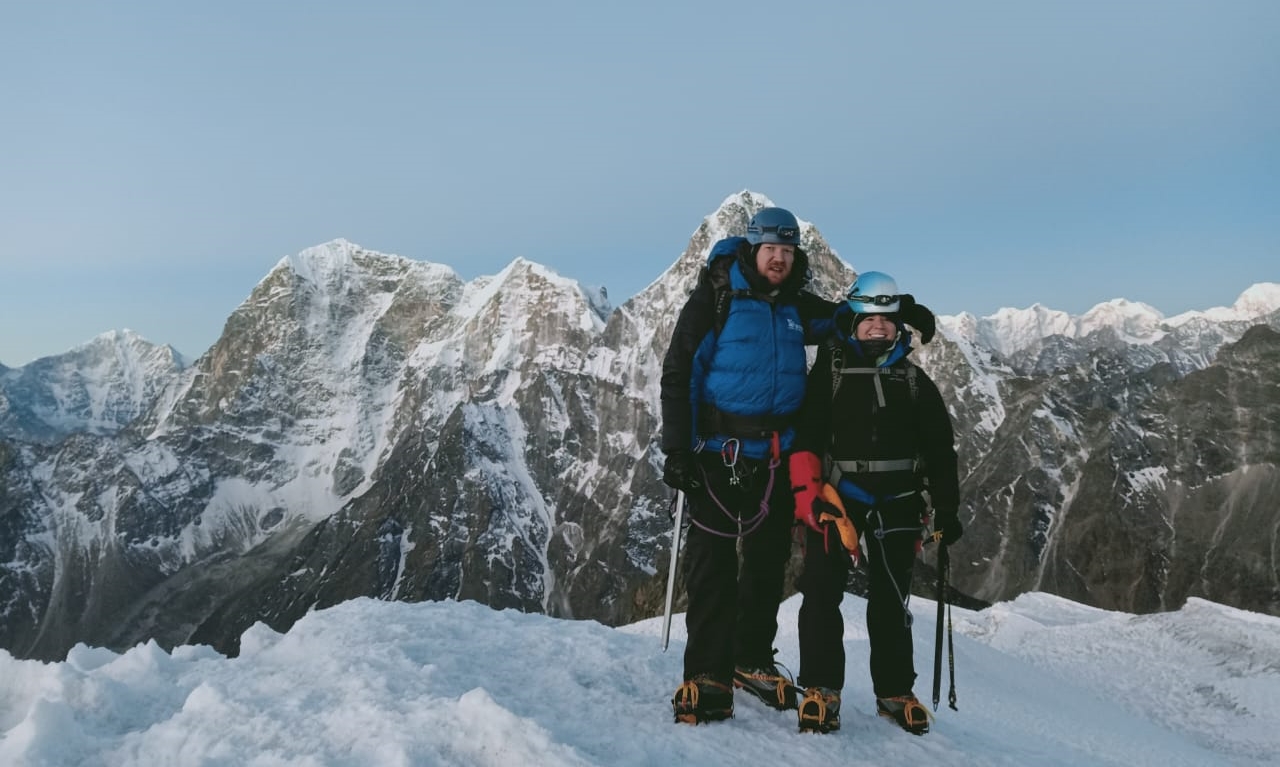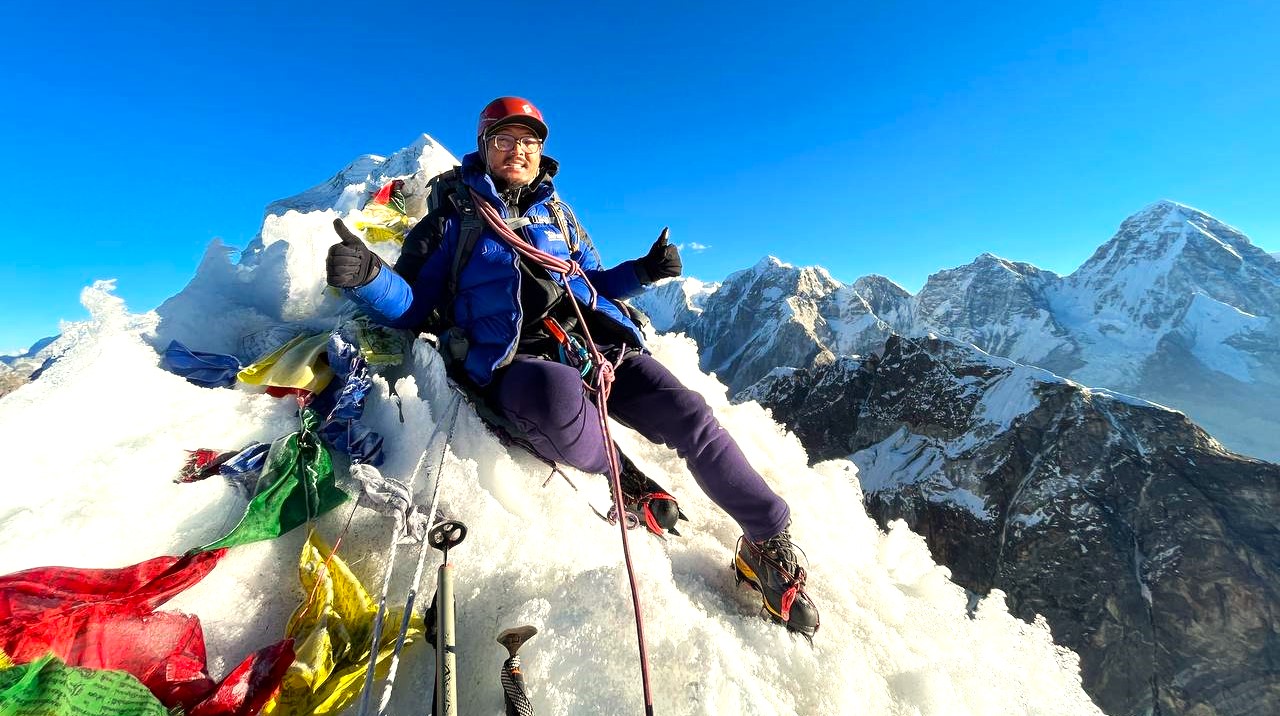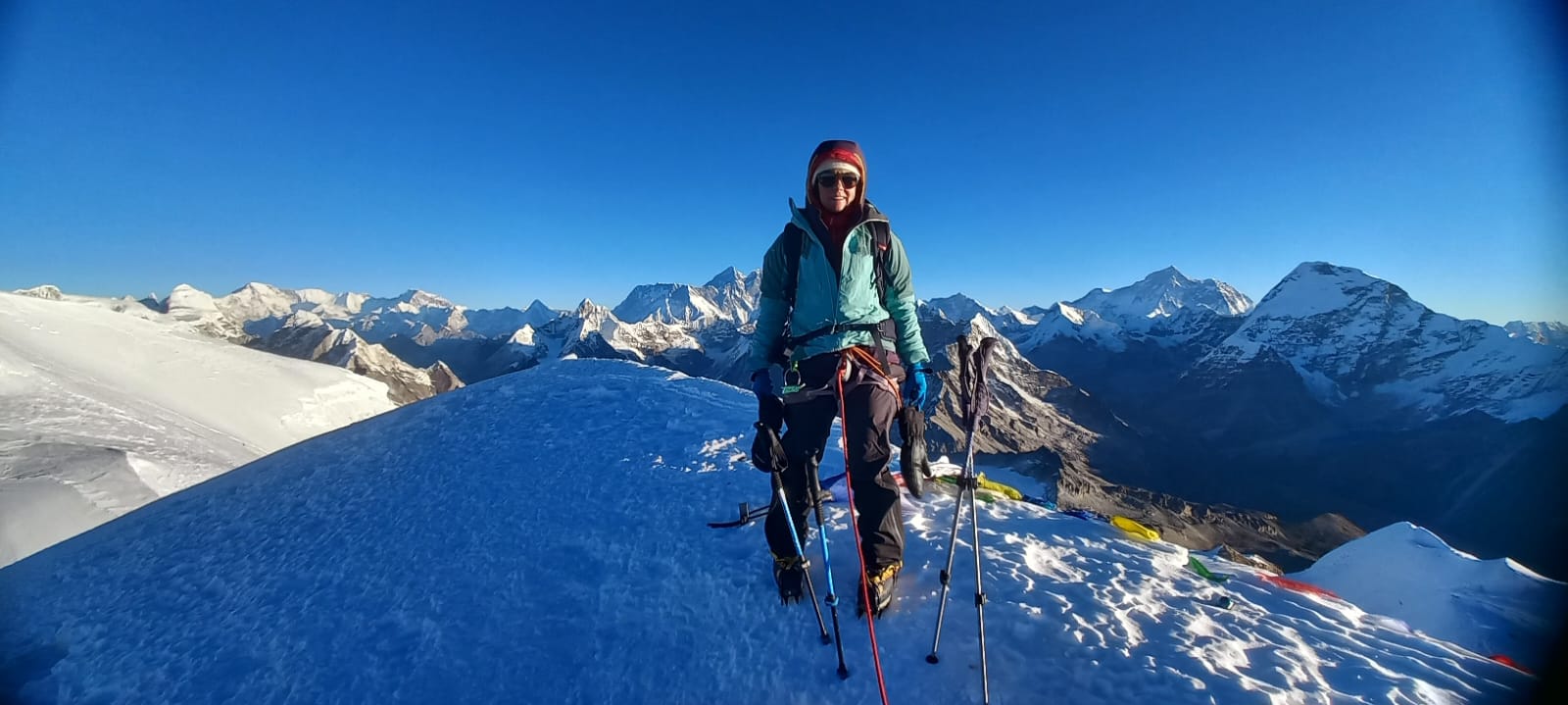26th August, 2025

Jul 18, 2024
Lobuche Peak Climbing In September
- What time of year is best to climb Island Peak?
- How long does it take to climb Lobuche?
- How hard is it to get to Lobuche Peak?
- How much does it cost to climb Lobuche Peak?
- Highlights of Lobuche Peak Climbing in September
- Advantages of Lobuche Peak Climb in September
- What Should I Pack for Lobuche Peak Climb
- Can I Do Lobuche Peak Without Guide
- How Much is Lobuche Peak Climb Cost
- Is Lobuche Peak Harder Than Island Peak
- Can I Do Lobuche Peak with Everest Base Camp
- Lobuche Peak Climbing Cost: Guide, Porter, Permit, Accommodation
- How Hard to Climb Lobuche Peak
- Tips For Climb Lobuche Peak
- What Kind of Training Required For Lobuche Peak Summit
- Can I Hire Equipment from Dingboche
- Conclusion
- Lobuche Peak Climbing Packages
Climbing Lobuche Peak in September offers a captivating adventure in the heart of Nepal's Everest region, blending the thrill of mountaineering with stunning Himalayan landscapes. September marks the end of the monsoon season, bringing clear skies, crisp air, and lush greenery to the trails. This transitional period offers optimal weather conditions for climbers, with stable temperatures and reduced precipitation compared to earlier months.
The journey typically begins with a scenic flight from Kathmandu to Lukla, followed by a trek through picturesque Sherpa villages like Namche Bazaar and Dingboche, where trekkers acclimatize while enjoying breathtaking views of peaks like Ama Dablam and Thamserku. The trail gradually ascends through alpine forests, glacial moraines, and rocky terrain, leading to Lobuche Base Camp at approximately 4,900 meters (16,076 feet).
Lobuche Peak (6,119 meters / 20,075 feet) itself presents a challenging yet achievable climb for climbers with basic mountaineering skills. The ascent involves technical sections including steep slopes, rocky ridges, and glaciated terrain, requiring the use of crampons, ice axes, and ropes under the guidance of experienced Sherpa guides.

LOBUCHE PEAK CLIMBING
Lobuche East (6,119m/20,075ft), set in Nepal's stunning Khumbu on the Nepalese side of Everest.The best time to go trekking in Nepal is in Autumn (September-November) and in...
Summit day typically begins before dawn, with headlamps lighting the way up the icy slopes. As the sun rises, climbers are rewarded with panoramic views of Everest, Lhotse, Nuptse, and other towering peaks of the Khumbu region. Descending back to base camp and trekking through the Everest region offers a chance to reflect on the accomplishment amidst some of the world's most spectacular scenery.
Overall, climbing Lobuche Peak in September combines the thrill of mountaineering with the beauty of Nepal's Himalayas during a transitional season, making it a memorable and rewarding adventure for enthusiasts seeking a challenging yet accessible peak in the Everest region.
What time of year is best to climb Island Peak?
The optimal time to climb Island Peak is during the pre-monsoon (spring) and post-monsoon (autumn) seasons in Nepal. Generally, the best months are April to May and late September to October. During these periods, the weather is stable with clear skies, making for safer and more enjoyable climbing conditions. The temperatures are moderate, and the views of the surrounding Himalayan peaks are breathtaking. These months also coincide with the peak trekking and climbing seasons in the Everest region, ensuring well-established routes, ample support services, and a vibrant trekking atmosphere.
How long does it take to climb Lobuche?
The duration to climb Lobuche Peak varies depending on the chosen route and individual acclimatization needs. Typically, the ascent from Lobuche Base Camp to the summit takes about 10-14 days round-trip from Lukla. This timeframe includes trekking to base camp, acclimatization hikes, and the actual climb. Climbers spend several days at higher camps to acclimatize properly before attempting the summit push. The descent usually takes 2-3 days, including trekking back to Lukla. Overall, climbers should plan for a total expedition duration of approximately 16-18 days, allowing for flexibility due to weather conditions and individual fitness levels.
How hard is it to get to Lobuche Peak?
Getting to Lobuche Peak involves a challenging trek and technical climbing skills. The journey begins with a flight from Kathmandu to Lukla, followed by a trek through the picturesque Sherpa villages of the Everest region. The trail ascends gradually, passing through forests, crossing suspension bridges, and eventually reaching higher altitudes where the terrain becomes rugged and the air thinner. Acclimatization is crucial to prevent altitude sickness and ensure a successful climb. The climb itself requires proficiency in using crampons, ice axes, and ropes to navigate steep slopes and glaciated terrain. Experienced Sherpa guides provide essential support, knowledge of the route, and ensure safety throughout the expedition. While challenging, Lobuche Peak is achievable for climbers with previous high-altitude trekking experience and basic mountaineering skills.

LOBUCHE PEAK SUMMIT RETURN BY HELICOPTER
A real climbing adventure that will leave you stunned at the beauty of the Himalayan Mountains. The Lobuche Peak Climbing expedition in the spectacular Khumbu region of Nepal has been ranked by Lonely...
How much does it cost to climb Lobuche Peak?
The cost of climbing Lobuche Peak varies depending on several factors, including the climbing season, the trekking agency chosen, the level of service, and group size. On average, the cost can range from $3,000 to $6,000 per person for a guided expedition. This cost typically covers permits, trekking and climbing logistics (including meals, accommodation, and equipment), experienced guides, porters, and transportation within Nepal. Additional expenses may include international flights, travel insurance, personal gear, visa fees, and tips for guides and support staff. Choosing a reputable trekking agency with a proven track record ensures safety, quality of service, and a well-organized expedition to Lobuche Peak.
Highlights of Lobuche Peak Climbing in September
Climbing Lobuche Peak in September offers a remarkable adventure amidst Nepal's post-monsoon season. The weather during this time is generally stable with clear skies and crisp air, providing optimal conditions for climbing. The trails leading to Lobuche Base Camp showcase lush greenery and vibrant landscapes post-monsoon, enhancing the trekking experience. As climbers ascend higher, they are treated to breathtaking views of towering Himalayan peaks such as Everest, Lhotse, and Nuptse. The route to Lobuche Peak involves crossing scenic Sherpa villages, traversing glacial moraines, and navigating technical sections with the assistance of experienced Sherpa guides. Summiting Lobuche Peak, standing at 6,119 meters (20,075 feet), offers a sense of achievement and rewards climbers with panoramic vistas of the Khumbu region's iconic peaks. Descending back through the stunning landscapes of the Everest region completes a memorable journey filled with natural beauty and cultural immersion.
Advantages of Lobuche Peak Climb in September
Climbing Lobuche Peak in September presents several advantages for mountaineers. The post-monsoon season offers stable weather conditions with clear skies, reducing the likelihood of precipitation and providing excellent visibility for climbing. The moderate temperatures make trekking and ascending more comfortable compared to colder months. Trails are less crowded in September, allowing for a quieter and more peaceful trekking experience amidst the stunning landscapes of the Everest region. The lush greenery and blooming flowers add a picturesque backdrop to the journey, enhancing the overall aesthetic appeal. With fewer climbers on the route, there's more flexibility in scheduling and less competition for accommodations at base camps and higher altitudes. Experienced guides and support staff ensure safety and logistical support throughout the expedition, making September an ideal time for climbers seeking a challenging yet rewarding adventure in Nepal's Himalayas.

LOBUCHE PEAK EXPEDITION 15 DAYS
Lobuche Peak Expedition is a thrilling adventure that takes you to the heart of the Khumbu region in Nepal. The peak stands at an altitude of 6,119 meters and offers stunning views of the surrounding...
What Should I Pack for Lobuche Peak Climb
Packing for a Lobuche Peak climb requires careful consideration of essential gear and clothing suitable for high-altitude mountaineering. Key items include a down jacket or insulated layers to keep warm during cold nights and summit pushes. Waterproof and windproof outer layers protect against unpredictable weather conditions. Quality trekking boots with sturdy soles provide traction on rocky and icy terrain, while crampons and ice axes are essential for navigating glacial sections. Pack a comfortable backpack with a hydration system or water bottles to stay hydrated throughout the trek. Sun protection gear like sunglasses, sunscreen, and a wide-brimmed hat shield against intense UV rays at higher altitudes. Bring a headlamp with extra batteries for early morning starts and late returns. Personal items such as toiletries, medications, and a camera to capture the breathtaking landscapes complete the packing list. Consult with your trekking agency for specific gear requirements and recommendations based on current weather conditions and route conditions for the best experience on your Lobuche Peak climb in September.
Can I Do Lobuche Peak Without Guide
While it is technically possible to climb Lobuche Peak without a guide, it is highly recommended to go with a professional guide for safety and logistical reasons. Lobuche Peak (6,119 meters / 20,075 feet) involves technical climbing skills such as using crampons, ice axes, and ropes on steep and glaciated terrain. Experienced guides provide essential support, navigation expertise, and ensure proper acclimatization to minimize risks of altitude sickness. They are familiar with the route, weather conditions, and emergency procedures, enhancing safety and overall experience. Additionally, guides manage permits, accommodation, and logistics, allowing climbers to focus on the ascent and enjoy the journey without logistical worries. While some experienced climbers may choose to attempt Lobuche Peak independently, the guidance and support of a qualified guide significantly increase the chances of a successful and safe climb.
How Much is Lobuche Peak Climb Cost
The cost of climbing Lobuche Peak varies depending on several factors, including the trekking agency, services included, group size, and climbing season. On average, the cost ranges from $3,000 to $6,000 per person for a guided expedition. This cost typically covers permits, accommodation at base camps, meals, climbing equipment, experienced Sherpa guides, and porters. Additional expenses may include international flights to Nepal, travel insurance, personal gear, visa fees, and tips for guides and support staff. Climbing during peak seasons (spring and autumn) may be more expensive due to higher demand for services and permits. It's advisable to choose a reputable trekking agency with a proven track record to ensure safety, quality of service, and a well-organized expedition to Lobuche Peak.

Three Peak Expedition
Embark on an unforgettable journey to the heart of the Himalayas as you conquer three majestic peaks: Mera Peak, Island Peak, and Lobuche Peak. This ultimate adventure combines technical climbing, bre...
Is Lobuche Peak Harder Than Island Peak
Lobuche Peak and Island Peak (Imja Tse) are both challenging climbs in Nepal's Everest region, each with its own unique characteristics. Lobuche Peak is slightly higher at 6,119 meters (20,075 feet), compared to Island Peak at 6,189 meters (20,305 feet). Both peaks require technical climbing skills, including the use of crampons, ice axes, and ropes on steep and glaciated terrain. The difficulty of each climb can vary depending on individual fitness, acclimatization, weather conditions, and route chosen. Generally, climbers consider Island Peak to have slightly more technical sections, including a steeper final ascent to the summit. However, Lobuche Peak is known for its challenging ridge climb and exposure to high altitude. Both peaks require proper training, acclimatization, and guidance from experienced Sherpa guides to ensure safety and success. Ultimately, the difficulty of each climb is subjective and varies based on individual experience and preparation.
Can I Do Lobuche Peak with Everest Base Camp
Combining a Lobuche Peak climb with a trek to Everest Base Camp (EBC) is a popular adventure in the Everest region of Nepal. The journey typically begins with a flight from Kathmandu to Lukla, followed by a trek through picturesque Sherpa villages and breathtaking landscapes. Trekkers acclimatize gradually as they ascend towards EBC, soaking in panoramic views of iconic Himalayan peaks. After reaching Everest Base Camp and exploring the Khumbu Icefall, climbers continue to Lobuche Base Camp for acclimatization and preparation. The climb to Lobuche Peak involves technical sections and requires proficiency in mountaineering skills under the guidance of experienced Sherpa guides. Combining EBC with Lobuche Peak offers a comprehensive Himalayan adventure, showcasing both cultural immersion and high-altitude climbing challenges.
Lobuche Peak Climbing Cost: Guide, Porter, Permit, Accommodation
The cost of climbing Lobuche Peak includes several components essential for a successful expedition. A guided climb typically costs between $3,000 to $6,000 per person, depending on the trekking agency, services provided, and group size. This cost covers permits required for climbing Lobuche Peak, accommodation at base camps, meals, and logistical support from experienced Sherpa guides. Guides play a crucial role in route navigation, safety management, and ensuring proper acclimatization throughout the ascent. Porters assist in carrying equipment and supplies, easing the load for climbers during the trek. Additional expenses may include international flights to Nepal, travel insurance, personal gear (including clothing and equipment like crampons and ice axes), visa fees, and tips for guides and support staff. It's advisable to choose a reputable trekking agency with experienced guides to ensure safety, quality of service, and a well-organized expedition to Lobuche Peak in Nepal's Everest region.

ISLAND PEAK CLIMBING
Sherpa Expedition & Trekking (Est.1977) are pleased to announce FOR ADVENTURERS the most awesome, exhilarating & unforgettable climbing and treks on offer anywhere today!...
How Hard to Climb Lobuche Peak
Climbing Lobuche Peak presents a significant challenge even for experienced mountaineers due to its technical aspects and high altitude. At 6,119 meters (20,075 feet), Lobuche Peak requires climbers to navigate steep slopes, rocky terrain, and glaciated sections. The climb involves using crampons, ice axes, and ropes to ascend safely. The final ridge to the summit is particularly demanding, requiring concentration and endurance. Proper acclimatization is crucial to mitigate the risks of altitude sickness. Despite its challenges, Lobuche Peak rewards climbers with breathtaking views of Everest, Lhotse, Nuptse, and other Himalayan giants, making it a memorable and rewarding endeavor for those prepared for its demands.
Tips For Climb Lobuche Peak
Acclimatization: Spend adequate time acclimatizing at various altitudes to minimize altitude sickness.
Physical Fitness: Train beforehand with cardio, strength, and endurance exercises.
Gear Preparation: Ensure you have quality mountaineering gear and clothing suitable for high altitudes.
Hydration and Nutrition: Stay hydrated and eat balanced meals to maintain energy levels.
Follow Guide's Advice: Listen to your Sherpa guide for route guidance, safety protocols, and pace.
Weather Awareness: Monitor weather forecasts and be prepared for changing conditions.
Mental Preparation: Stay focused, positive, and mentally resilient during challenging sections.
Following these tips enhances safety, enjoyment, and the overall success of your Lobuche Peak climb.
What Kind of Training Required For Lobuche Peak Summit
Training for Lobuche Peak should focus on building both physical and mental strength to handle the demands of high-altitude mountaineering. Cardiovascular exercises such as hiking, running, and cycling improve endurance, essential for sustained effort at high altitudes. Strength training with weights or bodyweight exercises strengthens muscles, especially in the legs, core, and upper body needed for carrying loads and maneuvering on rocky terrain. Practice using mountaineering equipment like crampons, ice axes, and ropes under the guidance of an experienced instructor or guide. Mental preparation involves developing resilience to handle physical challenges, altitude effects, and varying weather conditions. Adequate rest and recovery are equally important to optimize training benefits and ensure readiness for the climb.

YALA PEAK CLIMBING
Don’t let the height frighten you (5520m). This is a non-technical climb that will afford views for miles and miles in the Langtang region of Nepal. From the summit, you can see Mt. Sishapangma...
Can I Hire Equipment from Dingboche
Dingboche, a popular stop for trekkers and climbers in the Everest region, offers rental services for mountaineering equipment. While options may vary, you can typically rent essential gear such as crampons, ice axes, helmets, and sleeping bags. Renting equipment locally in Dingboche can be convenient for climbers traveling light or those needing specific items for their Lobuche Peak ascent. It's advisable to check the condition and quality of rented gear beforehand and ensure it meets your requirements for safety and comfort during the climb. Local rental shops may also provide insights into current weather conditions, route updates, and other valuable information for climbers preparing to summit Lobuche Peak.
Conclusion
Climbing Lobuche Peak is a challenging yet immensely rewarding adventure in Nepal's Everest region. At 6,119 meters (20,075 feet), this technical climb requires preparation, determination, and respect for the high-altitude environment. Proper training in mountaineering skills, physical fitness, and acclimatization is essential for a safe and successful ascent. Hiring experienced Sherpa guides not only enhances safety but also enriches the journey with local knowledge and support. The climb offers stunning views of Himalayan peaks and a sense of accomplishment that stays with climbers long after they descend. Whether you're a seasoned mountaineer or embarking on your first high-altitude climb, Lobuche Peak promises an unforgettable experience amidst Nepal's majestic Himalayas.
Lobuche Peak Climbing Packages
Lobuche Peak Summit Return By Helicopter
Lobuche Peak Expedition 14 Days
Lobuche Peak Expedition 15 Days

CHULU FAR EAST PEAK CLIMBING
Are you looking for adventure, natural beauty, magnificent snow-capped peaks, and unique cultural experience?This Peak Climbing will give you all the thrills, variety, and the adrenalin rush as you cl...
Any Questions? Let Us Know.
Recent Posts
17th June, 2025


















